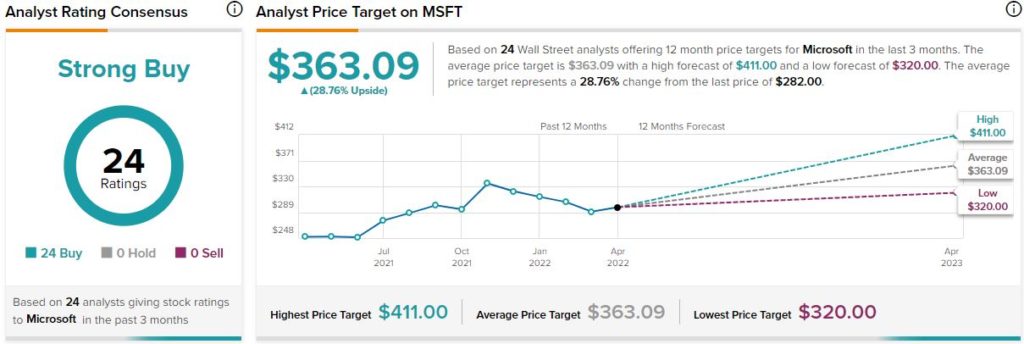Microsoft (MSFT) stock clocked in some impressive numbers for its latest quarter. Still, it was the upbeat outlook that allowed it to shine as its FAANG peers sagged lower.
Stay Ahead of the Market:
- Discover outperforming stocks and invest smarter with Top Smart Score Stocks
- Filter, analyze, and streamline your search for investment opportunities using Tipranks' Stock Screener
Undoubtedly, Microsoft has been a standout winner this earnings season, topping each of the FAANG stocks. Though Apple (AAPL) clocked in a record result, its guidance left investors jittery, leaving Microsoft as one of the last pillars of stability holding up the big tech trade amid this vicious market sell-off.
The Quarter That Saw FAANG Stocks Fumble
The FAANG names are the bluest of blue-chip technology stocks, but they suffered some severe turbulence in recent weeks. Some may think the group deserves to be broken up. Others may believe that the weakness in the group could cause the rest of the market to roll over further.
While it wasn’t the best quarter for FAANG, I view Microsoft as the firm that may have single-handedly saved the market from a more vicious decline, perhaps one that would’ve seen the S&P 500 fall into a bear market.
Microsoft’s incredible results give me confidence, not just in the firm moving into a rockier environment, but in all of big tech and even FAANG. Thanks to execution by its brilliant CEO Satya Nadella, Microsoft looks ready to enter rally mode as Wall Street analysts look to upgrade.
While broader market headwinds may delay such a post-earnings rally, I view MSFT stock as a standout play that’s well worth its premium price tag. I remain incredibly bullish on Microsoft stock.
Microsoft Stock: Applaud-Worthy Quarter, Great Guidance
In this type of market environment, where there’s fear in the hearts of investors, it’s going to take a lot more than an earnings beat to prevent a decline. Microsoft not only clocked in a stellar result that saw Azure flex its muscles, but it also delivered some decent guidance. It was a classic beat and raise at a time when rare misses and downbeat guides have become the norm.
With geopolitical uncertainties, high inflation, ongoing supply chain woes, and a potential recession on the horizon, it’s arguable that downbeat guidance would be most conservative. In that regard, Microsoft’s constructive guide is a decisive vote of confidence that the firm can continue moving forward, even as the gusts it faces increase in magnitude.
Third-quarter revenues surged 18% year over year. There was notable double-digit growth across numerous segments, but it was Azure’s 46% year-over-year growth that was worthy of applause. Indeed, Microsoft Azure is not slowing down anytime soon, with long-term contracts and sizeable deals powering the solid numbers.
Azure Powers Microsoft to Incredible Results
Undoubtedly, Azure has evolved to become a significant growth driver at Microsoft. While some may doubt the company’s growth prospects, the long-time tech darling continues to find new growth levers to pull to resist the growth-eroding effect of corporate aging. Thanks to its CEO Satya Nadella, Microsoft continues to reinvent itself.
The fast-growing cloud space still has many years of high double-digit growth left in the tank. If anything, Azure could take share en route to becoming number one in the public cloud, given the many dedicated customers who desire to stay within the Microsoft ecosystem.
Moving ahead, I’d look for Azure to continue powering Microsoft’s high-teens revenue growth as it looks to enjoy the full force of secular tailwinds in the digital transformation trend. It’s not just Azure that investors should get excited about, though. Microsoft’s Xbox gaming division looks to be in a spot to change the video-gaming world as we know it.
Xbox: The Next Frontier of Growth?
In prior pieces, I noted that Xbox Game Pass and Xbox Cloud Gaming were two offerings that would change the video-gaming market as we know it. If the Activision Blizzard (ATVI) deal goes through (Warren Buffett seems to think it will, given his merger arbitrage bet), Microsoft will not only have one of the deepest lineups of video-game brands, but it will be able to offer it to gamers at a deal that will make it hard for rivals to match.
Activision’s Call of Duty and Blizzard’s Diablo are two epic titles that could draw massive crowds towards Microsoft’s Xbox Game Pass service. Undoubtedly, Microsoft’s massive scale and deep pockets allow it to offer consumers extraordinary value with its monthly subscription.
Though video games are a wildly-competitive field, Microsoft already has the foundation and library to build a moat around its share of economic profits in the gaming world. Once the metaverse goes live, it will be nearly impossible, even for a big tech rival, to catch up to Microsoft.
Though Microsoft will never have a monopoly in gaming, it has set itself in a position to become a top-two global behemoth in an industry ripe for further consolidation.
For now, Microsoft’s gaming division is growing at a high-teens rate. When you factor in Xbox console shortages and the fact that Xbox Cloud Gaming is still just in beta, it seems more apparent that the division is poised for some much higher growth in the years ahead.
Suppose Activision Blizzard is given the green light. In that case, gaming could be in for some Azure-like growth, as consumers stop buying games outright, opting instead to subscribe to Xbox Game Pass.
Wall Street’s Take
Turning to Wall Street, MSFT stock comes in as a Strong Buy. Out of 24 analyst ratings, there are 24 Buy recommendations.
The average Microsoft price target is $363.09, implying upside potential of 28.8%. Analyst price targets range from a low of $320.00 per share to a high of $411.00 per share.

The Bottom Line on Microsoft
Microsoft’s Azure really pulled through in the latest quarter, allowing it to beat and raise at a time when its FAANG peers fumbled on guidance, earnings, or both.
With an ambitious gaming foundation, look for the Xbox division to take its growth to the next level. While it may not enjoy Azure-like growth anytime soon, I think that a notable growth acceleration is achievable from the segment as it solidifies its position as the Netflix (NFLX) of games.
Discover new investment ideas with data you can trust.
Read full Disclaimer & Disclosure
















